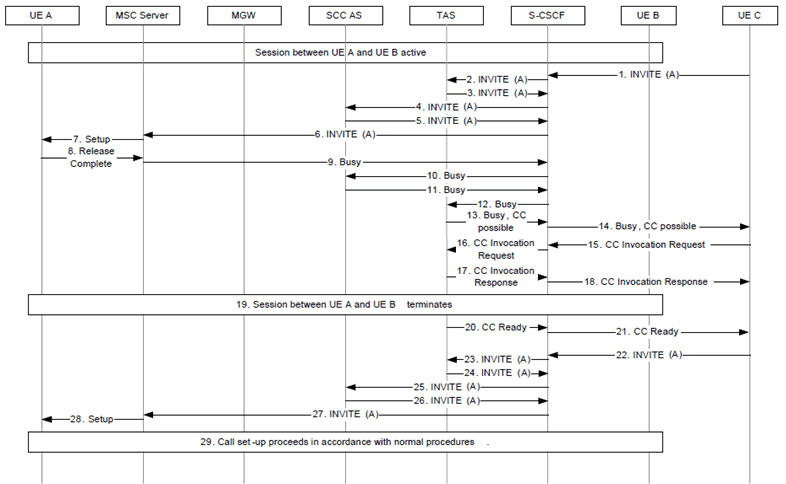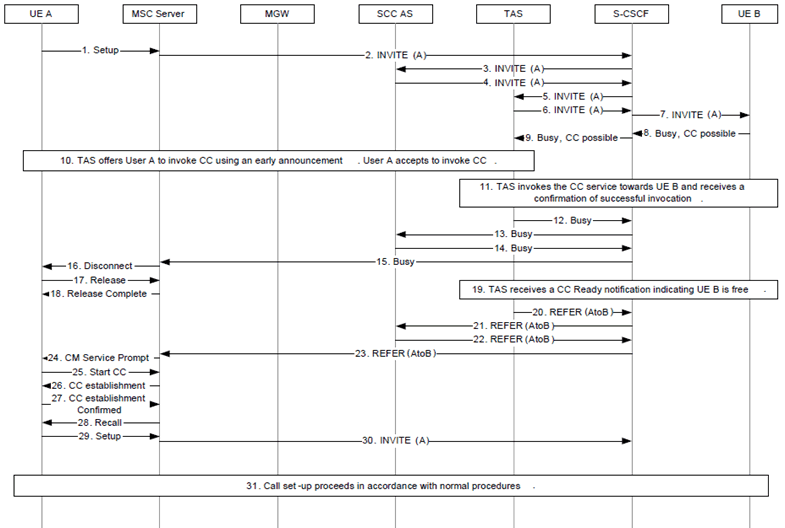Content for TS 23.292 Word version: 18.0.0
1…
4…
5…
7…
7.2…
7.3…
7.3.2.2…
7.3.2.2.4…
7.4…
7.4.2.2…
7.4.2.2.3…
7.4.2.2.7…
7.5…
7.6…
7.6.1.2.2.6…
7.6.1.2.3…
7.6.1.2.3.5…
7.6.1.2.3.6…
7.6.2…
7.6.2.7
7.6.2.8…
7.6.2.11…
7.6.3…
7.7…
7.7.2…
7.9…
7.9.2…
7.9.2.4
7.9.2.5
8…
A…
G…
H…
H.5…
H.5.3…
7.6.2.11 Communication Completion on Busy Subscriber/No Reply/Not Logged In
7.6.2.11.1 Communication Completion Terminated at Served User
7.6.2.11.2 Communication Completion Originated at Served User
...
...
7.6.2.11 Communication Completion on Busy Subscriber/No Reply/Not Logged In |R11| p. 92
7.6.2.11.1 Communication Completion Terminated at Served User p. 92
For IMS sessions established by UEs, where the I2 reference point is used, the MSC Server enhanced for ICS shall perform the necessary interworking between the I2 reference point and CS signalling (e.g. as described in TS 24.093) to allow Communication Completion to be controlled by the IMS.
Figure 7.6.2.11.1-1 describes how IMS CCBS is performed via the MSC Server enhanced for ICS. CCNR and CCNL follow the same principles. The following Figure assumes that UE A has an ongoing call.

Figure 7.6.2.11.1-1: IMS Communication Completion to Busy Subscriber via MSC Server enhanced for ICS
(⇒ copy of original 3GPP image)
(⇒ copy of original 3GPP image)
There is an ongoing session between UE A and UE B.
Step 1.
An incoming INVITE is received at the S-CSCF of UE A.
Step 2-6.
Via Initial Filter Criteria the INVITE is forwarded to the TAS and the SCC AS, before it is forwarded to the MSC Server.
Step 7.
The MSC Server enhanced for ISC sends a Setup message to UE A to inform it of the incoming call. Depending on CW settings the MSC Server enhanced for ICS may send a Busy response immediately.
Step 8.
UE A responds with a Release Complete message with cause "user busy".
Step 9.
The MSC Server enhanced for ISC maps the Release Complete message to a SIP Busy message.
Step 10-12.
The SIP Busy message is forwarded via SCC AS and S-CSCF to the TAS.
Step 13.
The TAS adds a CC possible indicator to the Busy response.
Step 14.
The Busy response is forwarded towards UE C.
Step 15.
A CC Invocation Request is received at the S-CSCF of UE A.
Step 16.
The CC Invocation Request is forwarded to the TAS.
Step 17.
The TAS accepts the CC Invocation Request, sends a CC Invocation Response towards UE C and begins supervising UE A for becoming not busy.
Step 18.
The CC Invocation Response is forwarded by the S-CSCF towards UE C.
Step 19.
The Session between UE A and UE B terminates.
Step 20.
After an appropriate time to allow UE A to initiate a call, the TAS sends a CC Ready notification towards UE C.
Step 21.
The CC ready notification is forwarded by the S-CSCF towards UE C.
Step 22.
An INVITE Request resulting from the CC ready notification is received by the S-CSCF.
Step 23.
The INVITE Request is received by the TAS.
Step 24.
After appropriate checking that the INVITE request is resulting from the CC ready notification the TAS forwards the INVITE request to the S-CSCF.
Step 25-29.
The call set-up proceeds in accordance with normal procedures.
7.6.2.11.2 Communication Completion Originated at Served User p. 94
For IMS sessions established by UEs, where the I2 reference point is used, the MSC Server enhanced for ICS shall perform the necessary interworking between the I2 reference point and CS signalling (e.g. as described in TS 24.093) to allow Communication Completion to be controlled by the IMS.
Figure 7.6.2.11.2-1 describes how IMS CCBS is performed via the MSC Server enhanced for ICS. CCNR and CCNL follow the same principles. The following Figure assumes that UE B has an ongoing call.

Figure 7.6.2.11.2-1: IMS Communication Completion via MSC Server enhanced for ICS
(⇒ copy of original 3GPP image)
(⇒ copy of original 3GPP image)
There is an ongoing session between UE A and UE B.
Step 1-9.
A normal call set-up results in a Busy condition at user B. The TAS serving user A receives a Communication Completion possible indication.
Step 10.
The TAS offers Communication Completion to user A who accepts. The offer is by means of an early announcement.
Step 11.
The TAS invokes the CC service towards user B. The TAS is notified that the invocation is successful.
Step 12-18.
The Busy response without Communication Completion possible indication is sent towards UE-A. The MSC server enhanced for ICS terminates the session towards UE A without giving a the option of activating CCBS request.
Step 19.
TAS receives a CC ready notification indicating that UE B is free.
Step 20-23.
To start the recall procedure the TAS sends a REFER towards UE A.
Step 24-28.
The MSC server enhanced for ICS starts the recall following normal procedures.
Step 29.
After notification of the user and confirmation that CC call is desired UE A sends a Setup towards the MSC server enhanced for ICS.
Step 30.
The MSC server enhanced for ICS maps the Setup to an INVITE in accordance with normal procedures and forwards the request towards the S-CSCF.
Step 31.
Call set-up continues in accordance with normal procedures.